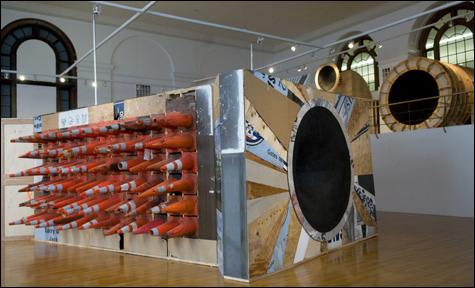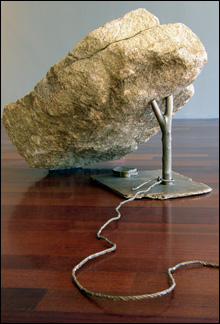
SAY WHA? Juan Ángel Chávez’s Speaker Project would be more impressive if the acoustics worked. |
“Speaker Project: Juan Ángel Chávez” | Massachusetts College Of Art And Design, 621 Huntington Ave, Boston | Through November 22
“Chris Frost: New Work” | Boston Sculptors Gallery, 486 Harrison Ave, Boston | Closed
“Dave Cole: All American” | Judi Rotenberg Gallery, 130 Newbury St, Boston | Through October 12
“Shifting Perspectives: Esteban Pastorino Díaz” | School Of The Museum Of Fine Arts Boston, 230 The Fenway, Boston | Through October 13 |
A couple years ago, The Dangerous Book for Boys appeared in England and became a hit. Designed to look like a 100-year old primer, it was a compendium of heroic adventure tales, Shakespearean quotes, knot tying, treehouse building, and go-cart mechanics. It was an arch, bookish, hipster-dad salvo against totally scheduled, protected childhoods, against people worrying too much about children skinning their knees, against our era of lawsuits and — dare I say it — feminism.
Art had already occupied this territory, and a spate of recent local exhibits could illustrate chapters from the book. The art features boy toys (no dolls, thank you very much), gadgets, and secret clubhouses. Like The Dangerous Book for Boys, it’s about Y-chromosome nostalgia. The guys embrace their inner adolescent, pursuing whole-hog things you couldn’t when you were a kid because of homework or the sun setting or having to keep the volume down.
At Massachusetts College of Art and Design’s Paine Gallery, Chicago’s Juan Ángel Chávez has erected what looks like a giant stereo speaker, with sound cones at each end, for The Speaker Project. It’s a patchwork shanty cobbled together from scavenged wood, bottles, signs, traffic cones, and foam, all with a romantic worn look. It could be a dream clubhouse for the guys from High Fidelity. It’s the kind of thing that you imagine turning on (if there were actually anything in it to turn on) and having blood explode out of your ears.
On the gallery’s balcony are three listening huts, similarly cobbled together from cast-off materials, with various vents and speaker cones that resemble a basement inventor’s version of Dr. Seuss architecture. (They’re titled Storefront, Down and Out, and Fallen Can.) It all looks rad, but it’s a letdown when you realize that the acoustics in this “laboratory for sound” don’t really work.
The gallery has lined up dozens of musicians and DJs to play inside the speaker clubhouse between now and November 22. (Schedule at //speakerproject.livejournal.com.) At the exhibit opening, Cambridge cello-and-electric-marimba duo Goli performed. The music sounded pretty much the same no matter where you stood outside the speaker shanty. Chávez’s design functions more like a megaphone than speakers, which make sound by amplifying electronic vibrations. But the construction of the clubhouse has too many vents and openings to channel the sound well. The listening booths on the balcony mostly just muffle the sound a bit — except when you press your ear to one of the traffic cones lining the exterior wall of one of the structures. Then the sound goes all weird and echoey, amplifying conversations from a distance. It’s an eavesdropping device.

TRAP: Chris Frost’s playful sculptures make you
think about what we’re playing at. |
Somerville sculptor Chris Frost installed his own riff on the clubhouse at Boston Sculptors Gallery (a show that closed last weekend). Fort (2008) is a jury-rigged plywood tree rising to the gallery ceiling. Aluminum “planks” form a ladder up the trunk to aluminum “boards” that create a shelf fort between branches. On the floor nearby is Trap (2008), which resembles one of those traps seen in old cartoons. A boulder is held up by a stick, which can be yanked away by a rope when someone takes the bait — in this case a sandwich, the perfect lure for hungry guys or Yogi Bear. There’s a jaunty playful charm to these pieces, but Frost gets serious with his craftsmanship and materials, which often masquerade as something else.
In Trap, the stone is actually stone, but everything else is bronze. The effect is to give boyhood dreams and pranks an adult twist — the more sophisticated materials make us think about what we’re really playing at. And I think what we’re playing at is war.
America and war have been the subjects of Providence sculptor Dave Cole’s work for several years now. And you have to say he’s had good timing — curators and art writers are finding it more and more irresistible.
His show “All American” at Judi Rotenberg Gallery presents American flags made of bullets, finely crafted baby clothes made from recycled Kevlar military flak vests, and an M60 machine gun mounted on a child’s wagon towed by a tricycle (all painted desert tan). There seems to be a critique here about raising our kids in a war culture, but it’s a one-liner. Cole doesn’t much go in for complexity or subtlety. He leaves you little room to ponder after you get his joke/statement.